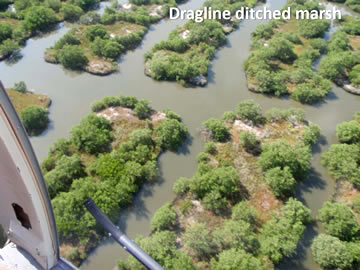The images portrays coastal wetlands restoration projects in which the St. Johns River Water Management District has been involved.
WETLANDS RESTORATION PROJECTS IN THE INDIAN RIVER LAGOON WILL CONTINUE TO BE A PRIORITY of the St. Johns River Water Management District and its partners during the next fiscal year.
The District has renewed contracts with the U.S. Fish and Wildlife Service, Brevard and Indian River mosquito control districts, and Volusia County for restoration work to continue in impacted Lagoon marshes.
Nearly 40,000 acres of coastal wetlands in the Lagoon were impounded and isolated for mosquito control in the late 1950s and early 1960s.
Isolating wetlands from the Lagoon reduced ecological productivity, resulting in reduced fish and wildlife; and the protection from storms that wetlands provide. Past work has reconnected more than 19,000 acres of impounded coastal wetlands through culvert and pump installations, as well as the removal of dikes that isolated the wetlands from the Lagoon.
“Through these partnerships, we have been able to transform thousands of acres of previously isolated wetlands into productive habitats for fish, wildlife and plants,” said District Executive Director Ann Shortelle. “Renewing contracts with our partners allows us to continue this important work.”
More than 8,300 acres of isolated impoundments remain in the lagoon, with more than 7,400 acres targeted for reconnection or rehabilitation.
The District’s tentative budget for fiscal year 2015‒2016, scheduled for adoption by the Governing Board on Sept. 22, includes up to $600,000 for wetlands restoration.
Planned work includes dragline ditch restoration in Volusia County, continued wetlands work in Brevard County and impoundment projects identified in Indian River County.
